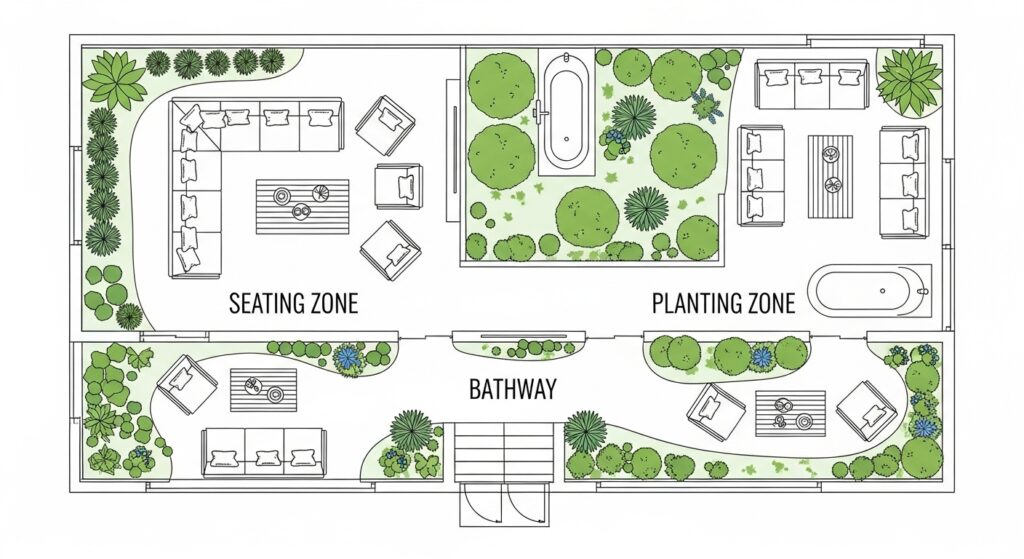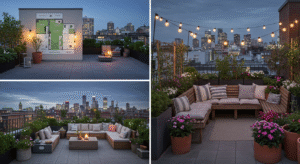Apartment living doesn’t rule out your green dreams. Apartment rooftop garden gives apartment dwellers a chance to enjoy nature, grow plants, and unwind in a quiet space above the city’s noise and activity.
Whether you call a trendy Kensington flat in London home or live in a bustling New York City apartment, you can design a rooftop garden. It’s doable and astisfying. Let’s look at some rooftop garden design tips that work well, spark creativity, and suit apartment life.
1. Get Permissions and Check Safety First
Before you plant anything, you need to check if your rooftop works for gardening.
Things to check:
- Building rules: Ask your landlord or building manager for guidance.
- Weight restrictions: Rooftop gardens can be heavy. Know how much weight your roof can hold.
- Water protection: Your rooftop garden needs a tough waterproof barrier to shield the building.
- Water removal: Make sure you have good drainage to stop water from pooling and causing harm.
It’s smart to talk to an engineer or someone who knows about rooftop gardens before you start your project.
2. Make a Plan That Fits Your Space
Apartment rooftop garden needs clever planning. Use every bit of space without making it feel cramped.
Design tips:
- Vertical gardens: Put up wall planters or trellises for climbing plants.
- Raised beds: These help you garden more and keep things tidy.
- Movable planters: Pick light containers you can move around when you need to.
Make sure paths stay clear and keep some open areas so your rooftop doesn’t feel too crowded.
3. Pick the Right Plants
Not all plants do well on a rooftop. It’s often windier, brighter, and more open than gardens on the ground.
Plants that work well on rooftops:
- Herbs: Basil, rosemary, thyme, mint.
- Vegetables: Tomatoes, peppers, leafy greens.
- Flowers: Lavender, geraniums, marigolds.
- Succulents: Great for dry sunny rooftops.
- Climbing plants: Ivy or jasmine can boost vertical beauty and privacy.
In London, Kensington rooftop gardens, English roses, and lavender are common. In contrast, New York City rooftop gardens often showcase native plants like coneflowers and ornamental grasses.
4. Think About Sun and Wind Protection
Rooftops are more exposed than other outdoor spaces. This results in more wind and sun exposure.
1. Actions You Can Take:
- Set up windbreaks: Bamboo screens, trellises, or lattice panels can shield against strong winds.
- Create shade: Use umbrellas, pergolas, or even tall plants to block out sunlight.
- Pick resilient plants: Choose plants that can withstand wind and sun to reduce damage.
Rooftop gardens in New York City might face stronger wind gusts, while those in Kensington may need more shade solutions because historic buildings block the wind.
5. Setting Up a Watering System
Watering poses one of the biggest challenges in rooftop gardening.
Options to think about:
- Self-watering containers. These containers conserve water and lessen the need for daily watering.
- Drip irrigation. This method delivers water slowly and steadily.
- Rainwater collection. If permitted, gather and store rainwater to use on your plants.
Hauling water buckets up several floors is exhausting. A well-designed watering system can help you save time and simplify garden maintenance.
6. Use Multi-Functional Furniture
Small spaces require smart furniture selections.
Creative ideas:
- Storage benches – Keep tools or pots inside.
- Chairs and tables that fold – Easy to store when you don’t need them.
- Seats built into the design – Save room and look nice with plants behind.
Your roof garden can serve as a place to unwind or even eat outdoors. Pick furniture that goes well with your plants and can stand up to the weather.
7. Choose Light Containers
Weight matters a lot in rooftop gardening. Pick materials that keep things light but still look good.
Best materials for containers:
- Plastic or fibreglass is light and simple to move.
- Fabric bags for growing work well for herbs and veggies.
- Wooden boxes with liners add a cozy feel without too much weight.
Steer clear of heavy stone or concrete unless your roof can handle the weight.
8. Use Lights to Create Atmosphere and Improve Safety
Keep enjoying your garden after the sun goes down. Install lights to use your rooftop later into the night.
Lighting choices: Solar lights. Green and simple to set up.
- Fairy lights. Boost charm and coziness.
- Path lights. Boost safety on walkways at night.
- Lanterns or battery candles. Set a calm mood for meals or get-togethers.
Well-lit rooftop gardens in New York City often become enchanting spots at night, ideal for hanging out or unwinding after a busy day.
9. Go Green on Your Roof
A rooftop garden offers a great chance to adopt eco-friendly habits.
Earth-friendly ideas:
- Compost: Set up a small bin for kitchen waste.
- Garden: Skip the harsh chemicals and pesticides.
- Plant native species: They need less care and help pollinators thrive.
- Repurpose containers: Plant in old buckets, crates, or wooden pallets.
These methods help the planet and cut costs in the long run.
10. Make It Your Own
Your rooftop garden should feel like a special retreat just for you.
Tips to add your personal touch:
- Put up art: Hang weather-resistant paintings or wall art.
- Play with color: Pick plants and furniture that show your style.
- Make a theme: Zen garden, English cottage, or simple retreat.
In London, Kensington rooftop gardens, many gardeners add classy touches like iron furniture or water fountains. On the other hand, New York City rooftop gardens often have cool urban decor like hammocks, bright rugs, or container veggie beds.
11. Make it Private
In busy cities, privacy is valuable. Plants and clever design can help.
Ways to create privacy:
- Tall grasses or bamboo – Fast-growing and attractive.
- Trellises with vines – Ivy or morning glory can hide views.
- Outdoor curtains – Perfect for relaxing or eating areas.
Rooftop gardening involves more than just plants. It aims to create a quiet, secluded haven away from the sounds and sights of nearby buildings.
12. Plan to Use Year-Round
While gardening peaks in spring and summer, you can design your space to enjoy throughout the year.
Winter-friendly features:
- Plants that stay green all year include boxwood and .
- Portable fire pit – Keep warm on cool nights.
- All-weather furniture – Tough and easy to maintain.
This approach enhances your garden’s usefulness in cooler cities such as New York. With suitable shade and vegetation, even rooftops in London can become inviting spaces.
13. Set a Budget and Stick to It
You can create a beautiful rooftop garden without spending a fortune.
Budget tips:
- Start small and expand over time. Use old crates or jars as planters.
- Purchase plants when they’re in season or from nearby nurseries.
- Create your features like trellis walls and furniture from pallets. By concentrating on imaginative answers and cost-effective selections, you can transform even modest rooftops into flourishing spaces.
14. Join Local Rooftop Gardening Communities
Getting help and ideas from others can make a difference.
Community benefits:
- Trade tools and advice with neighbors.
- Draw inspiration from other rooftop gardens in your city.
- Participate in online forums dedicated to rooftop gardening.
From seasoned rooftop gardeners in London’s Kensington to newcomers tending New York City rooftop plots, community gardening builds relationships and offers ongoing motivation.
15. Discover the upsides of rooftop gardening.
Rooftop gardens aren’t just for show. They offer real perks for the environment, your wallet, and your well-being.
Key advantages:
- Lower city heat: Green roofs cool down nearby areas.
- Clean the air: Plants remove pollution and give off oxygen.
- Cut energy bills: Rooftop gardens keep buildings warm and need less cooling.
- Help wildlife: Birds, bees, and butterflies make homes in these gardens.
- Control rainwater: Gardens lessen water flow and help drainage.
New York and London city councils are now pushing for more green roofs to tackle climate change.
16. Get Ideas from Real Rooftop Gardens. Looking at what others have done can spark new thoughts.
Inspiration from real life:
- Brooklyn’s 60 Water Street boasts a rooftop garden with many uses. It has structures for shade, places to sit, and areas for plants.
- A tiny terrace in New York City on Fifth Avenue comes with furniture you can move around, plants that stay green all year, and a shade you can pull back.
- In London, you’ll find many rooftop gardens in Kensington. These mix old English designs with new ways of planting in containers.
You can get ideas that match your area, taste, and weather by looking at rooftop garden projects near you or around the world.
To wrap up:
Rooftop gardening isn’t just a fad; it’s a way of life. City folks in places like London and New York are turning neglected rooftop areas into green getaways. With some good planning, fresh ideas, and clever gardening tricks, even the tiniest rooftop can become your little slice of urban heaven.
It all kicks off with a solid plan, whether you fancy sipping tea in your London Kensington-style hideout or taking in the skyline from your New York City rooftop oasis.
What’s your vision for the rooftop garden? Drop a comment below with your ideas or questions or contact us.








